The art and life of South Australian potter Milton Moon is celebrated in a new exhibition showcasing unique ceramic works from across his 60-year trailblazing practice.
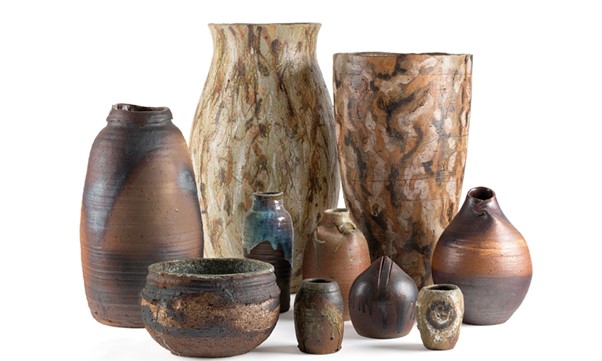
Various stoneware crafted by Milton during his decades-long career. All works, copyright Milton Moon Estate
Damon Moon has a clear childhood memory of taking a drive from Adelaide to Mount Lofty with his mum and dad and standing at the summit where public binoculars offered visitors a panoramic view over the city below. But his father, Milton, turned his sight in another direction. Looking back across Piccadilly Valley to the village of Summertown, he spotted a big old stone building.
“Dad looked at it and for some reason he went, ‘I’ll have that’… very soon after that he bought it. It was derelict, and he began to do it up.”
Only a year or so earlier, in 1969, the family had moved to Adelaide from Queensland, so Milton – today recognised as one of the most significant Australian potters of the 20th and early 21st centuries – could take up a role as head of ceramics at the South Australian School of Art.
Milton initially used that Summertown barn as a studio space because it offered room to make larger works, but on returning home in 1975 after a year in Japan, he quit his job to focus fully on his art and the family moved there to live.
“The house was on the top and then the space underneath was partly gallery and partly this large workshop. Mum and Dad stayed there until the 1990s… thousands upon thousands of people went through the place, to see and buy his work,” Damon says.
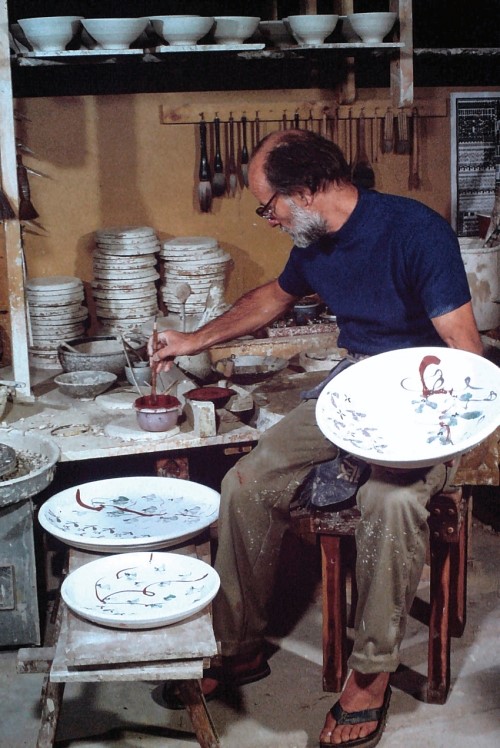
Milton Moon at work in his Summertown studio in the late 1970s. Image: Milton Moon archive
“I suppose an enormous amount of people in Adelaide remember him from that gallery in the Hills. It became a real destination.”
This month, a new exhibition opens at the Art Gallery of South Australia, celebrating Milton’s life and work.
AGSA curator of decorative arts and design, Rebecca Evans, brought to life the Milton Moon: Crafting modernism exhibition. She agrees that, while the artist was prolific throughout his 60-year practice, it was from the Summertown Pottery period that most South Australians will recognise his work, with many people either owning one of his pieces or knowing someone who does.
“Almost everyone in Adelaide – definitely most people over a certain age – will have a Milton Moon story… he produced so much work and he was so well-loved by South Australians,” Rebecca says.
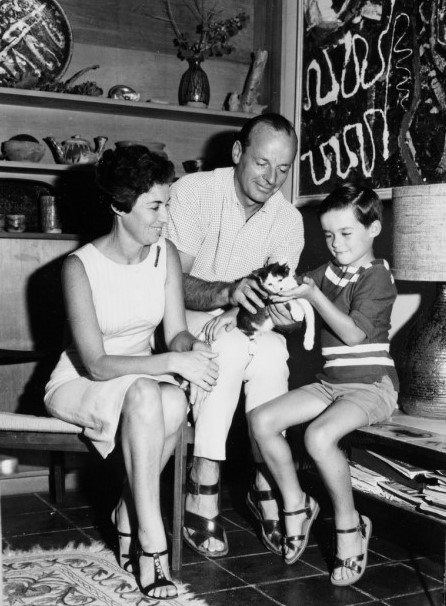
Milton with his family in the mid-1960s
The idea for the exhibition arose when AGSA held a memorial for Milton after he died in 2019, aged 92. Crafting modernism features 72 ceramic works – ranging from a series of earthenware coffee pots made for his first major exhibition in 1959 in Brisbane, to pieces made in the final years of his life when Rebecca says he was still creating “exceptional pots” using a small kiln at the unit where he then lived in Norwood.
It also includes archival material such as photographs, exhibition invitations and newspaper articles that were collected by Bette Moon, whose business skills, Rebecca says, were crucial to the success of her husband’s artistic career.
In the early years of the couple’s marriage, Bette ran a store in Brisbane selling Australian-made pottery and giftware, while Milton worked in broadcasting, including as a journalist and presenter with the ABC.
Damon, himself a ceramic artist and scholar, says his father had always been interested in art, but it wasn’t until the mid-1950s, when he was visiting the home of a commercial potter in Brisbane, that he was offered a chance to try his hand at the wheel.
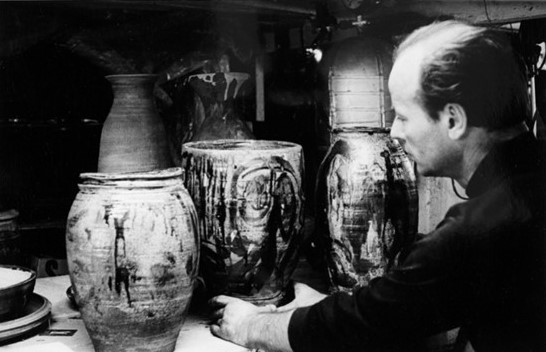
Milton Moon in his studio in Tarragindi, Queensland, in 1966. Image: John McKay, Milton Moon archive
“Dad sat down, and it was just one of those weird things – as soon as he touched clay, that was it,” Damon says.
Milton quit his job with the ABC, got a job teaching ceramics, and started exhibiting his work. In 1965 he won a Churchill Fellowship, which enabled him to travel overseas; almost a decade later, a Myer Foundation Geijutsu Fellowship took him to Japan.
He became known as a trailblazer of the modernist approach to ceramics and was made a Member of the Order of Australia (AM) in 1984 in recognition of his work.
Rebecca says distinctive features of Milton’s practice were his highly original and painterly style – reflecting the fact that many of his artistic contemporaries were painters – and his “unquenchable desire to make pots that were uniquely Australian”.
He was a keen bushwalker and scuba diver, with elements of the landscape and underwater world influencing the textures, shapes, and tonality of his ceramic works – one early piece, for example, has the gourd-like shape of a baobab seed, while other pots are encrusted with barnacles. In his later years, he found inspiration in the geology and landscapes of the Flinders Ranges.
The works in Crafting modernism illustrate key periods in the development of Milton’s practice, from those small earthenware ceramics of the late 1950s to his much larger, more conceptual works in clay. Some show the influence of Japanese culture following the year he spent there.
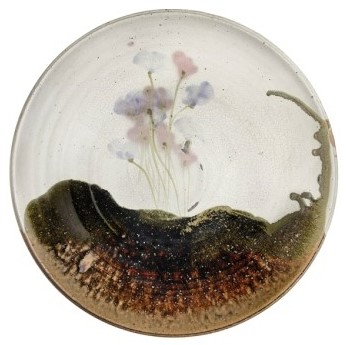
Plate, with blossom pattern, crafted in 1978 in Summertown
For Damon, ceramics have been a constant throughout his life. He started working with Milton in his Summertown studio around the age of 15 and went on to become an artist in his own right but was never hooked by it like his dad. Instead, he became a prolific writer and commentator on ceramics. He was also creative director of the ceramics studio at Adelaide’s JamFactory for several years.
Going through his father’s things after his death was a process of rediscovery as Damon found pots that had been packed away for years, some of which he hadn’t seen since he was a child. A number are on display in the exhibition, alongside works owned by AGSA and pieces on loan from other institutions and private collectors.
“I’m very fond of the early works and I’m very fond of the works he made when he was very, very old – for different reasons,” Damon says. “The works he made from, say, 1961 through to 1965, they are just astonishing… there was just always something a bit wild about what he did with the medium and there was a freedom to how he approached it which resulted in objects that were truly unique.”
That same freedom, he says, is evident in the pots Milton made towards the end of his life: “He’s used all of the things he’s seen and all of the things he’s done and he’s still able to make work that’s very idiosyncratic and very original… and I suppose it means a lot to me, too, because I realise that this is someone who knows that they won’t be doing it for very much longer. They’re his last works and it was very important to him that he kept making them.”
Milton Moon: Crafting modernismis showing at the Art Gallery of South Australia from May 6 until August 6.
This article first appeared in the May 2023 issue of SALIFE magazine.
Words: Suzie Keen


